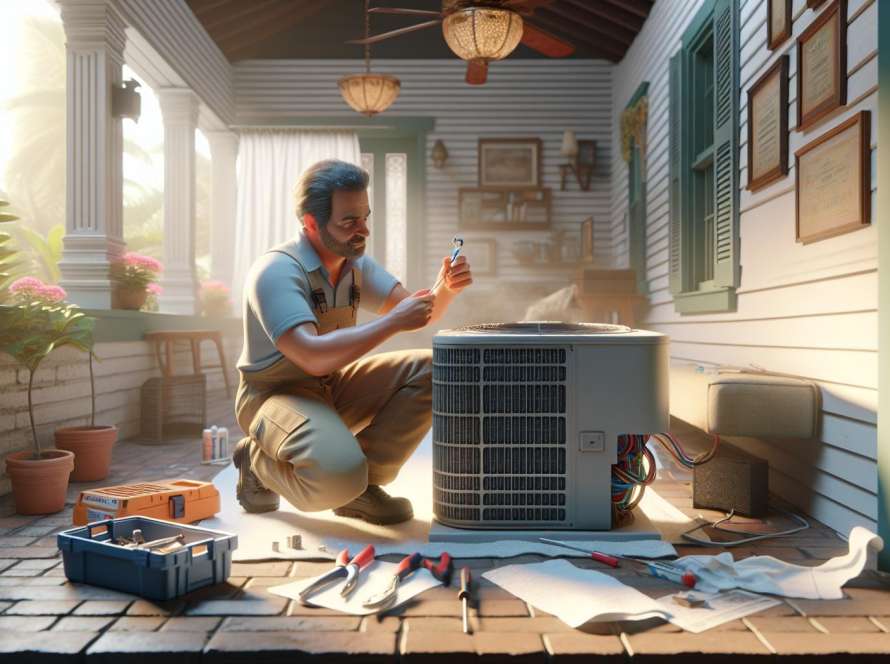So, you’re looking to maximize your solar AC performance in the Florida climate. When it comes to harnessing the power of the sun to cool your home efficiently, there are a few key strategies that can make all the difference. From selecting the right solar panels to optimizing their placement for maximum exposure, we’ve got you covered. Florida’s abundant sunshine offers a prime opportunity to not only reduce your carbon footprint but also cut down on those soaring energy bills. With our expert tips and tricks, you’ll be on your way to enjoying a cooler, more sustainable indoor environment in no time.
Selecting the Right Solar Panels
When considering Selecting the Right Solar Panels for your solar air conditioning system in Florida, it’s crucial to choose the most efficient and suitable option. Here’s a guide tailored for various experience levels to help you make the best choice:
For Beginners: Understanding the Basics
- Monocrystalline Panels: Known for high efficiency, but a bit pricier.
- Polycrystalline Panels: Cost-effective, good for tight budgets, slightly less efficient.
- Thin-Film Panels: Flexible, affordable, but less efficient than crystalline panels.
For Intermediate Users: Enhancing Your Solar Setup
- Consider Roof Space: Determine how many panels can fit within your available roof space.
- Efficiency Ratings: Look for panels with high efficiency ratings to maximize energy output.
- Warranty: Opt for panels with longer warranties for peace of mind and better investment protection.
- Solar Panel Brands: Research top-rated brands known for quality and performance.
- Financial Analysis: Calculate the cost per watt to ensure optimal long-term savings.
- Temperature Coefficient: Consider panels with lower temperature coefficients for better performance in Florida’s heat.
Keep in mind that selecting the right solar panels is a critical step in optimizing your solar air conditioning system for Florida’s climate. By choosing the most suitable panels, you can enhance efficiency, maximize energy output, and ultimately, enjoy a more sustainable and cost-effective cooling solution.
Optimizing Solar Panel Placement

When it comes to optimizing solar panel placement in Florida for the best AC performance, multiple factors come into play. Whether you’re a beginner looking to start harnessing solar power or an expert aiming to enhance your system’s efficiency, the right placement is critical. Here’s how you can tailor your approach based on your experience level:
For Beginners: Understanding the Basics
- Start by assessing your roof’s orientation to determine the best placement for maximum sun exposure.
- Consider potential shading from nearby structures or trees that could impact the panels’ efficiency.
- Consult with a professional to ensure proper installation and alignment of the panels.
For Intermediate Users: Fine-Tuning Your Placement
- Calculate the ideal tilt angle for your panels based on Florida’s latitude for optimal energy production.
- Utilize tools or software to simulate sun exposure throughout the day and identify the most productive areas on your roof.
- Explore options like tilt mounts or tracking systems to optimize sun exposure and energy generation.
- Implement strategic panel spacing to minimize shading effects between panels and maximize overall output.
- Incorporate smart technologies like microinverters to optimize energy production and monitor individual panel performance.
- Consider dual-axis tracking systems for advanced sun-tracking capabilities and increased efficiency.
By strategically placing your solar panels in alignment with your experience level and goals, you can significantly enhance your solar AC system’s performance in Florida’s sunny climate. Remember, the right placement is key to harnessing maximum solar energy for your cooling needs.
Utilizing Solar Batteries for Energy Storage
In our journey to optimize solar air conditioning performance in the Florida climate, energy storage plays a crucial role, especially when considering solar panel placement. Let’s delve into how utilizing solar batteries can enhance our overall system efficiency and energy management.
For Beginners: Understanding the Basics
- Start by choosing the right solar battery type based on your energy needs.
- Learn about battery capacity and how it impacts storing excess solar energy.
- Explore battery management systems to monitor and control energy flow effectively.
For Intermediate Users: Enhancing Energy Storage
- Calculate your energy consumption patterns to size the battery capacity accurately.
- Consider hybrid inverters for seamless integration of solar panels and batteries.
- Implement time-of-use strategies to optimize energy storage and reduce costs.
- Explore smart battery technologies for advanced monitoring and optimization.
- Integrate cloud-based energy management systems for remote monitoring and control.
- Implement demand-response programs to maximize energy savings and grid benefits.
By adopting a comprehensive approach to solar battery utilization, we can not only store excess energy efficiently but also contribute to a more sustainable and resilient energy ecosystem in Florida.
Incorporating Energy-Efficient Cooling Solutions
When it comes to optimizing solar AC performance in the warm Florida climate, incorporating energy-efficient cooling solutions is key. Let’s break down the steps for different user experience levels to ensure a successful and sustainable approach:
For Beginners: Mastering the Basics
- Start with regular maintenance: Keep your AC system in top condition by scheduling routine inspections and filter replacements.
- Utilize programmable thermostats: Set your thermostat to adjust temperatures based on your schedule to save energy.
- Implement proper insulation: Ensure your home is well-insulated to prevent energy wastage and enhance cooling efficiency.
For Intermediate Users: Enhancing Your System
- Consider smart thermostats: Upgrade to smart thermostats for precise temperature control and energy savings.
- Explore ductless mini-split systems: These systems offer zone cooling, allowing you to adjust temperatures in different areas for optimal comfort.
- Invest in energy-efficient HVAC units: Look for units with a high SEER rating to maximize energy efficiency and lower utility bills.
- Integrate solar panels: Combine your solar AC with solar panels to reduce reliance on the grid and further lower energy costs.
- Opt for variable refrigerant flow systems: These systems provide precise cooling control and energy efficiency for advanced climate control.
- Implement energy storage solutions: Incorporate battery storage systems like lithium-ion batteries to store excess solar energy for use during peak times.
Remember, optimizing your solar AC performance with energy-efficient cooling solutions not only helps you save on energy costs but also reduces your environmental impact. Let’s continue our journey towards a sustainable energy future in Florida.
Monitoring and Maintaining Solar AC System

Whether you’re just starting or you’re an experienced user, monitoring and maintaining your solar AC system is crucial for optimal performance in Florida’s climate. Let’s dive into some tips tailored to different experience levels:
For Beginners: Getting Started with Basic Maintenance
- Regularly clean or replace air filters to ensure efficient airflow.
- Inspect the outdoor unit for debris and clear any obstructions.
- Check thermostat settings and adjust for energy savings.
- Schedule professional maintenance at least once a year for a thorough check-up.
For Intermediate Users: Enhancing System Efficiency
- Consider installing a smart thermostat for precise temperature control.
- Explore ductless mini-split systems for zoned cooling and energy savings.
- Upgrade insulation to minimize energy loss and improve overall performance.
- Invest in energy-efficient HVAC units for long-term savings.
- Integrate solar panels to power your AC system and reduce grid dependency.
- Explore variable refrigerant flow systems for enhanced efficiency.
- Consider energy storage solutions like lithium-ion batteries for backup power.
- Implement remote monitoring to track system performance and troubleshoot issues proactively.
No matter your experience level, proper monitoring and maintenance will help you get the most out of your solar AC system in Florida. Stay proactive and optimize your system for peak performance in any season.
Conclusion
In optimizing solar AC performance in Florida’s climate, we’ve highlighted the importance of regular maintenance and monitoring. From basic upkeep for beginners to advanced strategies like integrating solar panels and energy-efficient systems, our focus remains on maximizing efficiency, reducing costs, and promoting sustainability. By following these guidelines, we can ensure that our solar AC systems operate at their peak performance levels, providing us with comfort and cost savings while contributing to a greener energy landscape in Florida.

